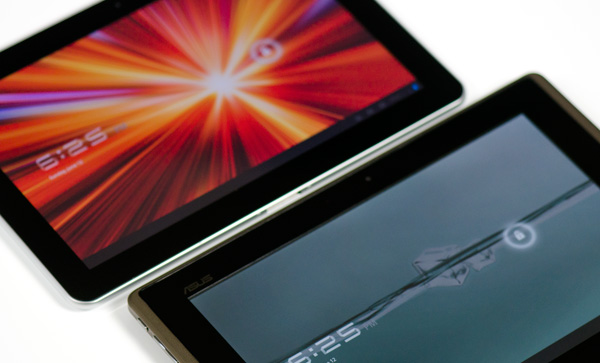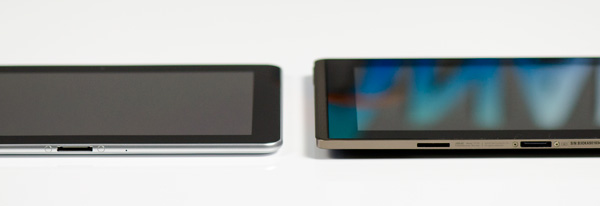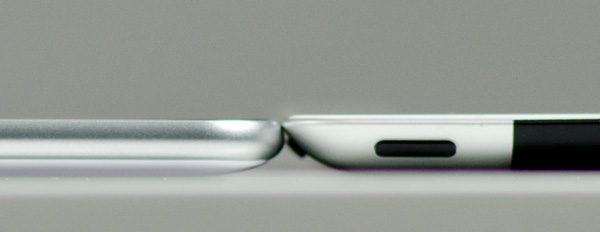Samsung Galaxy Tab 10.1 Review: The Sleekest Honeycomb Tablet
by Anand Lal Shimpi on June 13, 2011 5:07 AM EST- Posted in
- Tablets
- Samsung
- Tegra 2
- Galaxy tab 10.1
- Android 3.1
- Mobile
- NVIDIA
I remember standing in the audience of Samsung's CTIA press conference as it announced, for the first time ever, pricing and availability of its unreleased Galaxy Tab 10.1 and 8.9 before shipping. The smartphone (and early tablet) industries have gone this long without having to really compete based on price, mostly because in North America the carriers subsidize much of the cost. If every device costs $199 under contract, why get carried away with details like how much it actually costs?
The Galaxy Tab however was playing in a different space. While Apple ultimately caved to the pressures of carrier subsidies with the iPhone, the iPad remains completely unsubsidized and its followers buy it by the millions. The magical price point is $499 and it was at Samsung's CTIA press conference that it announced it would be matching Apple's $499 price point, and even dropping slightly below it for the 8.9-inch version.
At the time it seemed like a bold move, enough to give Honeycomb the fighting chance it needed. The Galaxy Tab would be thinner and lighter than the iPad 2 but competitively priced as well. This wouldn't be another Xoom.

Samsung Galaxy Tab 10.1 (top) vs. ASUS Eee Pad Transformer (bottom)
Then ASUS showed up. At $399, the Eee Pad Transformer not only offered a different usage model to the iPad and Galaxy Tab, it brought a lower price tag as well. Availability has been slim thanks to component shortages, but with the Eee Pad selling for $399 the Galaxy Tab at $499 all of the sudden seems overpriced.
| 2011 Tablet Comparison | ||||||
| Apple iPad 2 | ASUS Eee Pad Transformer | Motorola Xoom WiFi | Samsung Galaxy Tab 10.1 | |||
| SoC | Apple A5 (Dual ARM Cortex A9 @ 1GHz) | NVIDIA Tegra 2 (Dual ARM Cortex A9 @ 1GHz) | NVIDIA Tegra 2 (Dual ARM Cortex A9 @ 1GHz) | NVIDIA Tegra 2 (Dual ARM Cortex A9 @ 1GHz) | ||
| GPU | PowerVR SGX 543MP2 | NVIDIA GeForce | NVIDIA GeForce | NVIDIA GeForce | ||
| RAM | 512MB | 1GB | 1GB | 1GB | ||
| Display | 1024 x 768 IPS | 1280 x 800 IPS | 1280 x 800 | 1280 x 800 PLS | ||
| NAND | 16GB | 16GB | 32GB | 16GB | ||
| Dimensions | 241.2mm x 185.7mm x 8.8mm | 271mm x 175mm x 12.95mm | 249.1mm x 167.8mm x 12.9mm | 256.6 x 172.9 x 8.6mm | ||
| Weight | 601g | 695g | 730g | 565g | ||
| Price | $499 | $399 | $599 | $499 | ||
Based on specs alone you'd be right. Samsung's Galaxy Tab 10.1 has the same NVIDIA Tegra 2 tablet SoC inside,
1GB of LPDDR2 and 16GB of NAND on-board. You get a 10.1-inch 1280 x 800 PLS display and 802.11n WiFi support. It's worth pointing out that we're now well into the month of June and NVIDIA continues to be the only SoC vendor shipping in Honeycomb tablets. Samsung originally had plans to ship its own Exynos SoC in the Galaxy Tab but Tegra 2 remains the port of choice for all Honeycomb vendors at this point. Whether or not NVIDIA can win twice in a row with Ice Cream Sandwich later this year remains to be seen.

Samsung Galaxy Tab 10.1 (left) vs. ASUS Eee Pad Transformer (Right)
Where Samsung gives you something more for your money is in build quality and form factor. While Eee Pad Transformer feels surprisingly good for a cost reduced tablet, it doesn't feel nearly as slim or portable as the Galaxy Tab 10.1. It's no wonder Samsung went back to the drawing board on this one, the result is something that in many ways feels better than the iPad 2.
Apple still gets the nod in terms of quality of materials. The aluminum back of the iPad 2 is unbeatable. The Galaxy Tab 10.1 however feels lighter, a bit more rugged (I'm less concerned about scratching plastic than I am marring aluminum) and a little more comfortable to hold as a result. Against the Eee Pad there's no competition. I can live with the Eee Pad, but I much prefer the feel of the Galaxy Tab 10.1. The new Tab just feels like a device from this year - a compliment that, until now, I had only given to Apple.
The Galaxy Tab 10.1 measures just 8.6mm thick, 0.2mm thinner than the iPad 2. To be honest you really can't tell the difference, both devices feel thin. Ever after holding them back to back it's near impossible to tell that Samsung has built a thinner device. The most tangible difference in feel is the weight, not just in overall mass but in terms of weight distribution. The Galaxy Tab seems to carry the weight a bit better than the iPad, a bit more evenly.

Samsung Galaxy Tab 10.1 (left) vs. Apple iPad 2 (right)
Now is as good a time as any to point out that although Samsung calls this the Galaxy Tab 10.1, it's really the new Galaxy Tab 10.1. Originally Samsung announced a much thicker version at Mobile World Congress, a month prior to the CTIA announcement. With the much thinner iPad 2 hitting the market after the original 10.1 announcement, Samsung scrapped plans for the original and unveiled the thinner 8.6mm version as the new Galaxy Tab. The original Galaxy Tab 10.1 is now known as the Galaxy Tab 10.1v.












108 Comments
View All Comments
JasonInofuentes - Monday, June 13, 2011 - link
The tablet market is still behind about 3 years behind the notebook market, but it's catching up faster than the notebook caught up to PC. Five years ago many would ask, why would I pay $1500 for a laptop when I can get a desktop that runs circles around any laptop for just $500. Power advancements and easy access to wireless internet made us a mobile computing culture. Those same advancements will make the cost (in dollars and compromises) of a tablet negligible relative the notebook. Thanks for the comment, keep'em coming.ph00ny - Monday, June 13, 2011 - link
Anand,Have you tried the settings within the keyboard? It's surprising that you can't turn the predictive text on when every other device with samsung keyboard allows the user to turn it off
TEAMSWITCHER - Monday, June 13, 2011 - link
"I also encounter far too many crashes on a regular basis. "Please repost this review when the crashes are "few and far in between." With a kid in College and another on the way, I do not have the money to waste on a products such as this.
MadMan007 - Monday, June 13, 2011 - link
Seriously? If you're 'likely regret' a purchase in 4 months the answer is not to just buy the cheaper option, it's to buy nothing.
Pino - Monday, June 13, 2011 - link
No HDMI?!It's not for me, thank you!
vision33r - Monday, June 13, 2011 - link
"Hey the iPad 2 doesn't have HDMI, why don't you love me!" - Samsung Galaxy Tab 2.Belard - Tuesday, June 14, 2011 - link
LOL... good one.My Samsung Galaxy phone has the HDMI option on the menu... no HDMI port. But I can turn it ON and OFF.
iPads can transmit video wireless to TV, with an adapter.
mo.hasan - Tuesday, June 14, 2011 - link
You can buy a HDMI adapter for the Samsung 10.1. Personally I prefer slim and weight savings versus built in port. This is not a PC after all. This is 2011, time to put wireless DLNA to good use.Pjotr - Monday, June 13, 2011 - link
Page 2:"After prolonged usage I either orientation can be a problem, but..."
Say what?
jjj - Monday, June 13, 2011 - link
No microSD card, HDMI or USB should be dealbreakers for many (Samsung can go Apple themself).Ít's a shame that a nice tablet is limited to the onboard storage when even the dumbest dumbphone has a microSD slot nowdays.